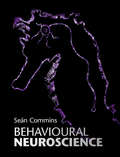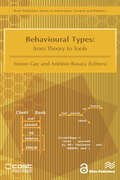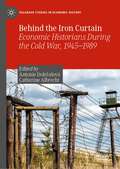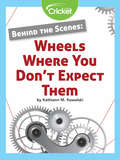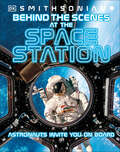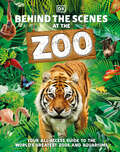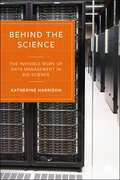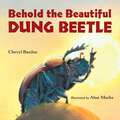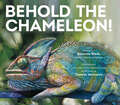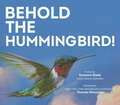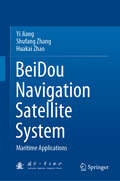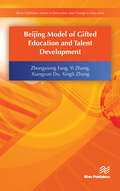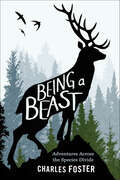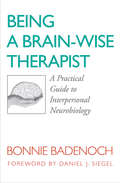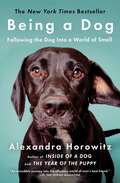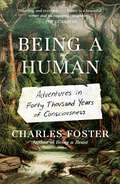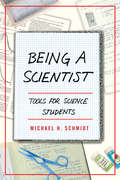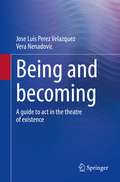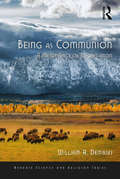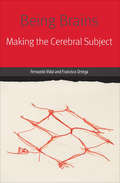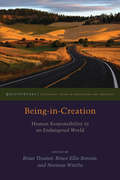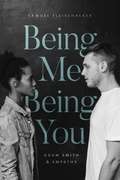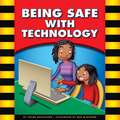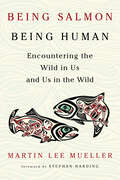- Table View
- List View
Behavioural Neuroscience
by Seán ComminsBrain and behaviour are intrinsically linked. Animals demonstrate a huge and complex repertoire of behaviours, so how can specific behaviours be mapped onto the complicated neural circuits of the brain?<P><P> Highlighting the extraordinary advances that have been made in the field of behavioural neuroscience over recent decades, this book examines how behaviours can be understood in terms of their neural mechanisms. Each chapter outlines the components of a particular behaviour, discussing laboratory techniques, the key brain structures involved, and the underpinning cellular and molecular mechanisms.<P> Commins covers a range of topics including learning in a simple invertebrate, fear conditioning, taste aversion, sound localization, and echolocation in bats, as well as more complex behaviours, such as language development, spatial navigation and circadian rhythms. Demonstrating key processes through clear, step-by-step explanations and numerous illustrations, this will be valuable reading for students of zoology, animal behaviour, psychology, and neuroscience.<P> Provides an introduction to brain, behaviour and neurons, drawing on examples from a wide range of behaviours and species from the simplest organisms to humans.<P> Offers step-by-step explanations of the mechanisms underlying various behaviours, helping students to understand complex neural processes.<P> A summary box at the end of each chapter poses open questions, stimulating further interest and encouraging readers to think about where their research might go next.
Behavioural Types: From Theory to Tools
by António Ravara Simon GayBehavioural type systems in programming languages support the specification and verification of properties of programs beyond the traditional use of type systems to describe data processing. A major example of such a property is correctness of communication in concurrent and distributed systems, motivated by the importance of structured communication in modern software. Behavioural Types: from Theory to Tools presents programming languages and software tools produced by members of COST Action IC1201: Behavioural Types for Reliable Large-Scale Software Systems, a European research network that was funded from October 2012 to October 2016. As a survey of the most recent developments in the application of behavioural type systems, it is a valuable reference for researchers in the field, as well as an introduction to the area for graduate students and software developers.
Behind the Iron Curtain: Economic Historians During the Cold War, 1945–1989 (Palgrave Studies in Economic History)
by Antonie Doležalová Catherine AlbrechtThis edited volume offers a systematic exploration of the relations between Western and Eastern scientists during the Cold War from the Eastern European perspective using the example of economic history. Introducing famous as well as almost forgotten scholars who attempted to eliminate the Iron Curtain and strove to break through the obstacles against the transfer of scientific ideas, the book challenges the narrative of the non-cooperative nature of scientific work during the Cold War due to socialist scientists’ incapability and disinclination to engage openly in international discussions. The book contributes to a deeper collective understanding of the multiple contemporary ideological and political circumstances that influenced scientific work and individual scientists' careers and explores the options scientists in socialist countries had - and utilized - to develop their research in collaboration with their Western colleagues.
Behind the Scenes: Wheels Where You Don't Expect Them
by Kathiann M. KowalskiCars, wagons, and other vehicles aren't the only places you'll find wheels . . . Be on the lookout for these and other working wheels.
Behind the Scenes at the Space Stations: Your All Access Guide to the World's Most Amazing Space Station (DK Behind the Scenes)
by DKYour all-access pass to spectacular space stations. Step inside one of humanity&’s greatest achievements with a behind-the-scenes guide to space exploration. Revealing a new perspective into the world of space exploration and the daring astronauts who make it possible, Behind the Scenes at the Space Station takes you on a once-in-a-lifetime tour of the space station. Learn what the astronauts do once they make it to the space station, from experiments to repairs and so much more! Have you ever wondered if plants can grow in outer space? Or how the space station doesn&’t break down in outer space? Or how astronauts go to the toilet in zero gravity? Behind the Scenes at the Space Station is a treasure trove of information. Did you know that during a 24-hour period, the space station completes 16 orbits of Earth and the astronauts on board see 16 sunrises and sunsets everyday? Or that the International Space Station is so enormous that it was launched in pieces and constructed in orbit? Brimming with astonishing visuals, step-by-step explanations of everyday space work in action, and job profiles of the adventurous people who make it happen, Behind the Scenes at the Space Station is the perfect way to experience life in space.
Behind the Scenes at the Zoo: Your All-Access Guide to the World's Greatest Zoos and Aquariums (DK Behind the Scenes)
by DKStep inside the weird and wonderful world of zoos, where all four corners of our planet come together. We&’re opening the gates, just for you! Join us on an epic behind-the-scenes adventure of zoos and aquariums. From tigers and tortoises to giraffes and jellyfish, you&’ll learn about hundreds of different animals and how they are looked after by their keepers.Inside the pages of this animal book for kids, you&’ll discover the secret delights of the world's most interesting zoos and more! It includes: • Descriptions of the conservation and ethical treatment of animals • An explanation of the vital research done by zoos. • Beautiful photos of animals and their innovative habitats in zoos around the world. • Breakdowns of the tasks of zoo staff, using language that&’s fun and accessible. All the fun of the zoo in just one book!Featuring only the best zoos from around the world, this conservation-themed children&’s book takes you on a once-in-a-lifetime trip through zoo life. It gives you a peek inside the hidden lives of the experts who care for the animals in the zoos and work passionately to conserve them in the wild, too. Learn how they create the perfect habitats, nutritious meals and fun enrichment activities to keep their animals healthy and happy. This wonderful children&’s educational book is ideal for teaching little ones about endangered animals.Behind the Scenes at the Zoo is packed with stunning images that encapsulate the essence of zoos, aquariums and wildlife parks, plus step-by-step explanations and job profiles of key roles like a zookeeper, veterinarian and wildlife biologist! It&’s the perfect gift for kids ages 9–12 who love all things animals. It&’s time to uncover the secrets of the incredible animals and army of staff that make up these extraordinary attractions and vital conservation centers! Are you ready?Take little ones on even more STEM-based journeys!If you loved this book about zoology for kids, look out for more Behind the Scenes titles from DK! Take an exclusive tour of the world's most exciting museums and discover their hidden treasures that aren't normally on public display with Behind the Scenes at the Museum.
Behind the Science: The Invisible Work of Data Management in Big Science
by Katherine HarrisonAvailable Open Access digitally under CC-BY-NC-ND licence. Some of the largest quantities of data produced today occur as the result of experiments taking place at Big Science facilities. This book tells the story of a unique research journey following the people responsible for designing and implementing data management at a new Big Science facility, the European Spallation Source (ESS) in Lund, Sweden. It critically examines the idea of data as an absolute ‘truth’ and sheds light on the often underestimated, yet essential, contributions of these data experts. Providing a unique glimpse into the inner workings of Big Science, this book fills an important gap in science and technology studies and critical data studies.
Behold the Beautiful Dung Beetle
by Cheryl BardoeDung is a precious pile of food and drink for these beetles.Simple science text and dramatic illustrations give a close-up view of the fascinating world of the dung beetle. When an animal lightens its load, dung beetles race to the scene. They battle over, devour, hoard, and lay their eggs in the precious poop. Dung is food, drink, and fuel for new life—as crucial to these beetles as the beetles are to many habitats, including our own.Back matter includes instructions for finding dung beetles, fun facts, glossary, and a selected bibliography.
Behold the Chameleon
by Suzanne SladeLyrical text and gorgeous illustrations introduce us to the chameleon and its astonishing abilities.This reptilian superhero can alter the pigments in its skin cells to change color, operate its eyes separately (allowing it to keep one eye on dinner and one out for predators), capture that dinner by lashing out its long, super-fast, sticky tongue at speeds up to 13 miles an hour, and use its prehensile tail as an anchor. Ranging in size from less than an inch (Nano-chameleon, possibly the world's smallest reptile) to about two feet long, the size of a house cat (Parson's Chameleon), the chameleon is something to behold!
Behold the Hummingbird
by Suzanne SladeLyrical text and gorgeous illustrations take flight in this exploration of the tiny, gorgeous hummingbirds and its astonishing abilities.Hummingbirds are tiny and pretty, so you might find yourself taking them for granted. But these little birds are remarkable, fierce, and talented. In Behold the Hummingbird, readers will learn about species that can hover like a helicopter, fly backwards and upside down, and consume half their body weight in a single day.
BeiDou Navigation Satellite System: Maritime Applications
by Yi Jiang Shufang Zhang Huakai ZhaoThis book highlights the maritime applications of Global Navigation Satellite Systems (GNSSs) with emphasis on BeiDou Navigation Satellite System (BDS). The book systematically summarizes the technical standards for maritime applications of GNSS issued by the International Maritime Organization (IMO), the International Telecommunication Union (ITU), and other relevant international organizations. It covers the development history and future prospects of the international standardization of BDS’ maritime applications. Various applications of BDS in maritime navigation, including the radio determination service system, the global maritime distress and safety system, the automatic identification system, the vessel monitoring system, the long-range identification and tracking system, and the maritime ground-based augmentation system, are introduced. Promising new directions are put forward. This book is intended for technical engineers in maritime communication and navigation. It is also a valuable reference for researchers, graduate students, and upper-level undergraduate students in maritime-related majors.
Beijing Model of Gifted Education and Talent Development
by Zhongxiong Fang Yi Zhang Xiangyun DuIn China, talent development has been one of the key areas of attention in national focus for the development of science and technology, education, and other areas over the past three decades, and it is especially emphasized in the national outline for medium- and long-term educational reform and development. Beijing is the leading city in educational reform, especially in the area of gifted education in mainland China. Over the past 35 years, through constant exploration and research, a comprehensive gifted education system called the Beijing Model of Gifted Education and Talent Development (BMGETD) has gradually been developed. This book presents a summary of the educational practices used in, and the research done on the BMGETD over these decades. This includes several patterns for gifted education, such as acceleration in special classes, special classes without acceleration, enrichment within regular classes, and a joint program among high schools, universities, and professional academic institutions.
Being a Beast: Adventures Across the Species Divide
by Charles FosterA passionate naturalist explores what it’s really like to be an animal—by living like themHow can we ever be sure that we really know the other? To test the limits of our ability to inhabit lives that are not our own, Charles Foster set out to know the ultimate other: the non-humans, the beasts. And to do that, he tried to be like them, choosing a badger, an otter, a fox, a deer, and a swift. He lived alongside badgers for weeks, sleeping in a sett in a Welsh hillside and eating earthworms, learning to sense the landscape through his nose rather than his eyes. He caught fish in his teeth while swimming like an otter; rooted through London garbage cans as an urban fox; was hunted by bloodhounds as a red deer, nearly dying in the snow. And he followed the swifts on their migration route over the Strait of Gibraltar, discovering himself to be strangely connected to the birds. A lyrical, intimate, and completely radical look at the life of animals—human and other—Being a Beast mingles neuroscience and psychology, nature writing and memoir to cross the boundaries separating the species. It is an extraordinary journey full of thrills and surprises, humor and joy. And, ultimately, it is an inquiry into the human experience in our world, carried out by exploring the full range of the life around us.
Being a Brain-Wise Therapist: A Practical Guide to Interpersonal Neurobiology (Norton Series on Interpersonal Neurobiology)
by Bonnie BadenochThis book, part of the acclaimed Norton Series on Interpersonal Neurobiology, brings interpersonal neurobiology into the counseling room, weaving the concepts of neurobiology into the ever-changing flow of therapy. Neuroscientific discoveries have begun to illuminate the workings of the active brain in intricate detail. In fact, sometimes it seems that in order to be a cutting-edge therapist, not only do you need knowledge of traditional psychotherapeutic models, but a solid understanding of the role the brain plays as well. But theory is never enough. You also need to know how to apply the theories to work with actual clients during sessions. In easy-to-understand prose, Being a Brain-Wise Therapist reviews the basic principles about brain structure, function, and development, and explains the neurobiological correlates of some familiar diagnostic categories. You will learn how to make theory come to life in the midst of clinical work, so that the principles of interpersonal neurobiology can be applied to a range of patients and issues, such as couples, teens, and children, and those dealing with depression, anxiety, and other disorders. Liberal use of exercises and case histories enliven the material and make this an essential guide for seamlessly integrating the latest neuroscientific research into your therapeutic practice.
Being a Dog: Following the Dog Into a World of Smell
by Alexandra HorowitzFrom the #1 bestselling author of Inside of a Dog and The Year of the Puppy—&“an incredible journey into the olfactory world of man&’s best friend&” (O, The Oprah Magazine), Alexandra Horowitz&’s follow-up to her New York Times bestseller explains how dogs experience the world through their most spectacular organ—the nose.In her &“fascinating book…Horowitz combines the expertise of a scientist with an easy, lively writing style&” (The New York Times Book Review) as she imagines what it is like to be a dog. Guided by her own dogs, Finnegan and Upton, Horowitz sets off on a quest through the cutting-edge science behind the olfactory abilities of the dog. In addition to speaking to cognitive researchers and smell experts, Horowitz visits detection-dog trainers and training centers; she meets researchers working with dogs to detect cancerous cells and anticipate epileptic seizure or diabetic shock; and she even attempts to smell-train her own nose. As we come to understand how rich, complex, and exciting the world around us is to the canine nose, Horowitz changes our perspective on dogs forever. Readers will finish this book feeling that they have broken free of their human constraints and understanding smell as never before; that they have, for however fleetingly, been a dog. And, as The Boston Globe says about Being a Dog, &“becoming more doglike, not surprisingly, can make anyone&’s life a little more vivid.&”
Being a Human: Adventures in Forty Thousand Years of Consciousness
by Charles FosterNAMED A BEST BOOK OF THE YEAR BY THE ATLANTIC, KIRKUS REVIEWS, AND NEW STATESMAN A radically immersive exploration of three pivotal moments in the evolution of human consciousness, asking what kinds of creatures humans were, are, and might yet beHow did humans come to be who we are? In his marvelous, eccentric, and widely lauded book Being a Beast, legal scholar, veterinary surgeon, and naturalist extraordinaire Charles Foster set out to understand the consciousness of animal species by living as a badger, otter, fox, deer, and swift. Now, he inhabits three crucial periods of human development to understand the consciousness of perhaps the strangest animal of all—the human being.To experience the Upper Paleolithic era—a turning point when humans became behaviorally modern, painting caves and telling stories, Foster learns what it feels like to be a Cro-Magnon hunter-gatherer by living in makeshift shelters without amenities in the rural woods of England. He tests his five impoverished senses to forage for berries and roadkill and he undertakes shamanic journeys to explore the connection of wakeful dreaming to religion. For the Neolithic period, when humans stayed in one place and domesticated plants and animals, forever altering our connection to the natural world, he moves to a reconstructed Neolithic settlement. Finally, to explore the Enlightenment—the age of reason and the end of the soul—Foster inspects Oxford colleges, dissecting rooms, cafes, and art galleries. He finds his world and himself bizarre and disembodied, and he rues the atrophy of our senses, the cause for much of what ails us.Drawing on psychology, neuroscience, natural history, agriculture, medical law and ethics, Being a Human is one man’s audacious attempt to feel a connection with 45,000 years of human history. This glorious, fiercely imaginative journey from our origins to a possible future ultimately shows how we might best live on earth—and thrive.
Being a Scientist: Tools for Science Students (G - Reference, Information And Interdisciplinary Subjects Ser.)
by Michael H. SchmidtBeing a Scientist is a comprehensive introduction to the many aspects of scientific life beyond the classroom and laboratory. Written with undergraduate science majors in mind, the book covers ethics, the philosophical bases of scientific methods, library research, reading, peer review, creativity, proposal and paper writing, and oral and poster presentations. In contrast to other texts in the field, which often take a simple prescriptive approach to these topics, Being a Scientist connects them to the historical and philosophical roots of modern science, as well as the common experiences of all people. Written in a conversational style, the book makes use of metaphor, historical anecdote, and hypothetical research about everyday household questions. This approach helps undergraduates learn basic research skills without being too intimidated by the advanced concepts, vocabulary, and methods which are encountered in looking at the current scientific literature. Being a Scientist is a textbook for a semester-long course devoted to teaching research and communication skills to undergraduate science majors, but it can be adapted for use in summer research experiences, capstone research courses, and other courses throughout the undergraduate curriculum.
Being and becoming: A guide to act in the theatre of existence
by Jose Luis Perez Velazquez Vera NenadovicMany people spend considerable time seeking a sense of purpose in life and, concomitant with that, a sense of personal identity. This book demystifies this search, revealing why this search is a fallacy. The purpose is to inform readers about results in neuroscience and biophysics that may guide us to some liberation needed in the current age of great complexity in life with a diverse burden of chores; a deliverance from some afflictions that prevent individuals from achieving the true purpose of our lives. Among these afflictions we find two primordial concerns: the belief and subsequent attachment to a self, and the conviction that life must have a deep purpose in which we are major players. While this is a scientific text, it can easily be read by a lay audience, written with minimal technical jargon and with references to scientific papers enough to satisfy the curious. We have tried to extract the essence of scientific observations such that we can glimpse at those aforementioned concerns about the self and life, observations which help us comprehend what we are and what we become, the being and becoming of our own selves and natural phenomena around us. Jose Luis Perez Velazquez received a PhD in Molecular Physiology & Biophysics. His research seeks principles of biological organisation. He worked at the Hospital for Sick Children in Toronto and was Professor at the University of Toronto. Currently he is a Research Scholar at the Ronin Institute and lives in the natural paradise of Asturias, in Northern Spain. Vera Nenadovic is a nurse practitioner, neuroscientist and entrepreneur. She has 30 years of experience in healthcare from First Nations communities to intensive care units. Her research focuses on predicting brain injury outcomes. She is a clinician and researcher at Holland Bloorview Kids Rehab Hospital. Her startup company BrainsView is commercializing software that analyzes brainwaves to monitor brain function and recovery after head injury. She is married and lives in Toronto, with her husband and Rottweiler.
Being And Time: A Revised Edition Of The Stambaugh Translation (Suny Series In Contemporary Continental Philosophy)
by Martin Heidegger Joan Stambaugh Dennis J. SchmidtThe publication in 1927 of Martin Heidegger’s magnum opus signaled an intellectual event of the first order and had an impact in fields far beyond that of philosophy proper. Being and Time has long been recognized as a landmark work of the twentieth century for its original analyses of the character of philosophic inquiry and the relation of the possibility of such inquiry to the human situation. Still provocative and much disputed, Heidegger’s text has been taken as the inspiration for a variety of innovative movements in fields ranging from psychoanalysis, literary theory, and existentialism to ethics, hermeneutics, and theology. A work that disturbs the traditions of philosophizing that it inherits, Being and Time raises questions about the end of philosophy and the possibilities for thinking liberated from the presumptions of metaphysics. The Stambaugh translation captures the vitality of the language and thinking animating Heidegger’s original text. It is also the most comprehensive edition insofar as it includes the marginal notes made by Heidegger in his own copy of Being and Time, and takes into account the many changes that he made in the final German edition of 1976. The revisions to the original translation correct ambiguities and problems that have become apparent since the translation first appeared. Bracketed German words have also been liberally inserted both to clarify and highlight words and connections that are difficult to translate, and to link this translation more closely to the German text. This definitive edition will serve the needs of scholars well acquainted with Heidegger’s work and of students approaching Heidegger for the first time.
Being as Communion: A Metaphysics of Information (Routledge Science and Religion Series)
by William A. DembskiFor a thing to be real, it must be able to communicate with other things. If this is so, then the problem of being receives a straightforward resolution: to be is to be in communion. So the fundamental science, indeed the science that needs to underwrite all other sciences, is a theory of communication. Within such a theory of communication the proper object of study becomes not isolated particles but the information that passes between entities. In Being as Communion philosopher and mathematician William Dembski provides a non-technical overview of his work on information. Dembski attempts to make good on the promise of John Wheeler, Paul Davies, and others that information is poised to replace matter as the primary stuff of reality. With profound implications for theology and metaphysics, Being as Communion develops a relational ontology that is at once congenial to science and open to teleology in nature. All those interested in the intersections of theology, philosophy and science should read this book.
Being Brains: Making the Cerebral Subject (Forms Of Living Ser.)
by Fernando Vidal Francisco OrtegaThis &“interesting, informative, and provocative book&” explores the pervasive influence of neuroscience and &“the view that we are essentially our brains&” (History and Philosophy of the Life Sciences). Being Brains offers a critical exploration of neurocentrism, the belief that &“we are our brains,&” which came to prominence in the 1990s. Encouraged by advances in neuroimaging, the humanities and social sciences have gravitated toward the brain as well, developing neuro-subspecialties in fields such as anthropology, aesthetics, education, history, law, sociology, and theology. Even in the business world, dubious enterprises such as &“neuromarketing&” and &“neurobics&” have emerged to take advantage of the heightened sensitivity to all things neuro. While neither hegemonic nor monolithic, the neurocentric view embodies a powerful ideology that is at the heart of some of today&’s most important philosophical, ethical, scientific, and political debates. Being Brains examines the internal logic of this new ideology, as well as its genealogy and its main contemporary incarnations. Being Brains was chosen as the 2018 Outstanding Book in the History of the Neurosciences by the International Society for the History of the Neurosciences.
Being-in-Creation: Human Responsibility in an Endangered World (Groundworks: Ecological Issues in Philosophy and Theology)
by Bruce Ellis Benson Norman WirzbaWhat is the proper relationship between human beings and the more-than-human world? This philosophical question, which underlies vast environmental crises, forces us to investigate the tension between our extraordinary powers, which seem to set us apart from nature, even above it, and our thoroughgoing ordinariness, as revealed by the evolutionary history we share with all life.The contributors to this volume ask us to consider whether the anxiety of unheimlichkeit, which in one form or another absorbed so much of twentieth-century philosophy, might reveal not our homelessness in the cosmos but a need for a fundamental belongingness and implacement in it.
Being Me Being You: Adam Smith & Empathy
by Samuel FleischackerModern notions of empathy often celebrate its ability to bridge divides, to unite humankind. But how do we square this with the popular view that we can never truly comprehend the experience of being someone else? In this book, Samuel Fleischacker delves into the work of Adam Smith to draw out an understanding of empathy that respects both personal difference and shared humanity. After laying out a range of meanings for the concept of empathy, Fleischacker proposes that what Smith called “sympathy” is very much what we today consider empathy. Smith’s version has remarkable value, as his empathy calls for entering into the perspective of another—a uniquely human feat that connects people while still allowing them to define their own distinctive standpoints. After discussing Smith’s views in relation to more recent empirical and philosophical studies, Fleischacker shows how turning back to Smith promises to enrich, clarify, and advance our current debates about the meaning and uses of empathy.
Being Safe with Technology
by Susan KesselringThis fun, colorful book describes basic rules for what to do and what not to do to be safe on your phone and online. Other books in this series are available in this library.
Being Salmon, Being Human: Encountering the Wild in Us and Us in the Wild
by null Martin Lee MuellerNautilus Award Silver Medal Winner, Ecology & Environment In search of a new story for our place on earthBeing Salmon, Being Human examines Western culture&’s tragic alienation from nature by focusing on the relationship between people and salmon―weaving together key narratives about the Norwegian salmon industry as well as wild salmon in indigenous cultures of the Pacific Northwest.Mueller uses this lens to articulate a comprehensive critique of human exceptionalism, directly challenging the four-hundred-year-old notion that other animals are nothing but complicated machines without rich inner lives and that Earth is a passive backdrop to human experience. Being fully human, he argues, means experiencing the intersection of our horizon of understanding with that of other animals. Salmon are the test case for this. Mueller experiments, in evocative narrative passages, with imagining the world as a salmon might see it, and considering how this enriches our understanding of humanity in the process.Being Salmon, Being Human is both a philosophical and a narrative work, rewarding readers with insightful interpretations of major philosophers―Descartes, Heidegger, Abram, and many more―and reflections on the human–Earth relationship. It stands alongside Abram&’s Spell of the Sensuous and Becoming Animal, as well as Andreas Weber&’s The Biology of Wonder and Matter and Desire―heralding a new &“Copernican revolution&” in the fields of biology, ecology, and philosophy.&“Philosophically, scientifically, morally, and artistically, Mueller blows the [salmon] industry guys literally out of the water. If you care about the future of salmon, you must read this essential, rigorously documented book.&”―Sy Montgomery, coauthor of Tamed and Untamed; author of The Soul of an Octopus&“A marvelous exploration of what it means to belong within life&’s community. Mueller integrates imagination and analysis to produce a book of rare and important insight.&”―David George Haskell, author of The Songs of Trees
